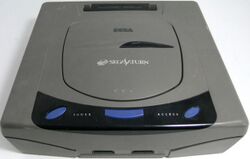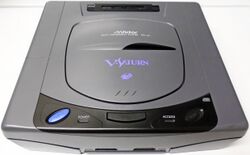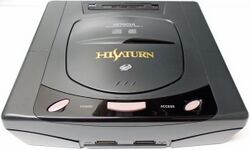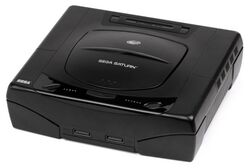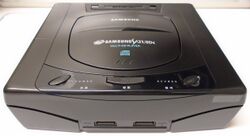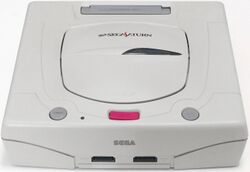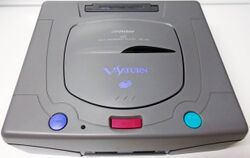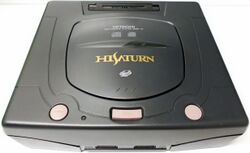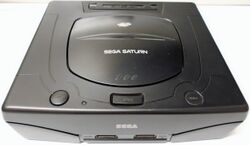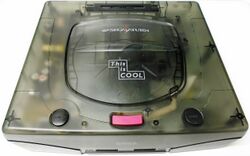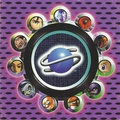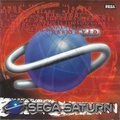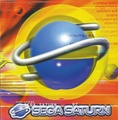Sega Saturn
From Sega Retro
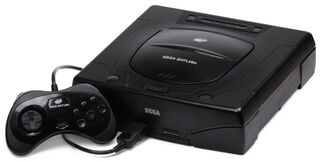
| |||||||||||||||||||||||||||||||||||||||||||||||||||||||
| Sega Saturn | |||||||||||||||||||||||||||||||||||||||||||||||||||||||
|---|---|---|---|---|---|---|---|---|---|---|---|---|---|---|---|---|---|---|---|---|---|---|---|---|---|---|---|---|---|---|---|---|---|---|---|---|---|---|---|---|---|---|---|---|---|---|---|---|---|---|---|---|---|---|---|
| Manufacturer: Sega | |||||||||||||||||||||||||||||||||||||||||||||||||||||||
| Variants: Sega Titan Video | |||||||||||||||||||||||||||||||||||||||||||||||||||||||
| Add-ons: Backup Memory, PriFun, Video CD Card, Extended RAM Cartridge, ROM Cartridge | |||||||||||||||||||||||||||||||||||||||||||||||||||||||
|
The Sega Saturn (セガサターン), is a video game console manufactured by Sega and was the successor to the Sega Mega Drive/Genesis (as opposed to add-ons such as the Sega 32X and Mega-CD). Initially released in 1994, the Saturn was a 32-bit compact disc-based system, and was a key player in what is now widely known as the fifth generation of video game consoles. The Saturn was first released on November 22, 1994 in Japan, May 11, 1995 in North America, and July 8, 1995 in Europe.
Depending on where you live, the Saturn could be described as either Sega's most successful console of all time (Japan) or one of their biggest commercial failures (North America). Despite being powerful for its time, its complex hardware and inability to meet rapidly evolving consumer expectations and demands put it in a distant third place in the Western world, but a combination of powerful 2D sprite rendering capabilities, ports of Sega arcade games and a strong marketing campaign involving Segata Sanshiro made the Saturn the most successful Sega console in Japan. Estimates for the total number of Saturns sold worldwide range from ten million to seventeen million.
The Saturn's main competitors were Sony's PlayStation released just a week after the Saturn in Japan, and the Nintendo 64 from September 1996. Its arcade counterpart was the Sega Titan Video (ST-V) system. It was replaced by the Sega Dreamcast in late 1998.
Contents
Hardware
The Sega Saturn is the successor to the Mega Drive, though as a video game system it is almost entirely different. It is a "32-bit" console, marketed in such a way that it appeared to be an evolution of the "16-bit" era of video gaming dominated by the Mega Drive and Super NES (which in turn succeeded the "8-bit" NES).
This description, however, was initially fabricated - Sega of Japan originally claimed the Saturn was a "64-bit" console[7] and some within Sega even chose to call it an "128-bit" machine[8], a number arrived at by cumulating processors rather than simply picking the main CPU. Alternatively some areas of Sega simply went down the "multi-processor" route, refusing to get drawn into the perceived differences between 32-bit and 64-bit[9]. This was incidentally the last video game generation where these so-called "bit wars" were considered to matter.
The system uses CD-ROMs as its primary choice of media. Though it contains a cartridge slot, this is not used for games, but rather backup memory or RAM cartridges. The former was to extend the space for save games beyond that of the Saturn's internal memory, while the latter was used to augment the Saturn's limited memory and to avoid long CD load times.
The Saturn has two controller ports, and the standard Saturn controller builds on that seen in the six button Sega Mega Drive controller. It adds two shoulder buttons, first seen on the Super NES controller, bringing the amount of buttons up to nine. The 3D Control Pad, released later with NiGHTS into Dreams, would supply the console with an analogue stick and analogue shoulder buttons, the latter later being used in the Sega Dreamcast before being adopted by Nintendo and Microsoft for their GameCube and Xbox consoles, respectively.
In comparison to the rival PlayStation, the Saturn is more powerful overall.[10] While the PlayStation can draw more polygons, the Saturn has more raw computational power and is faster at drawing individual pixels using its processors, whereas the PlayStation has to go through its polygon engine, giving the Saturn more flexibility in terms of programming.[11] When both SH-2 CPU processors, the SCU DSP and/or both VDP graphics processors are used in parallel, the Saturn is capable of more overall processing performance, fillrate, bandwidth and texturing. 2D games often used the VDP1 for foreground sprites and the VDP2 for multi-layered parallax scrolling backgrounds, giving the Saturn an advantage for 2D graphics. A similar comparative advantage could be seen for 3D graphics when using the VDP1 to draw foreground polygons and the VDP2 for background textures, while the DSP and/or both CPU calculate geometry. While Sega's first-party 3D games occasionally utilized both CPU, the DSP, and/or both VDP, most third-party 3D games only utilized a single CPU and the VDP1, just a portion of the Saturn's processing power.
The Saturn's quad polygons supported forward texture mapping, allowing limited perspective correction for 3D graphics, compared to the perspective distortion of the PlayStation's affine texture mapping. However, the Saturn's use of quads was not industry standard, compared to the PlayStation's triangle polygons. The Saturn was known for its difficult 3D development environment, due to its complex parallel processing hardware architecture, requiring familiarity with assembly language, lack of an operating system, and initial lack of C language support, useful development tools and graphics software libraries. The Saturn's VDP1 also had issues when it came to transparency for foreground objects, despite the VDP2 having fully functional transparency for backgrounds. While the VDP1 technically supported transparency, it had limitations which many developers found difficult to work around and instead resorted to dithering for VDP1 foreground objects.
The Saturn's VDP1 was the basis for Nvidia's first graphics processor, the NV1, which was one of the first 3D graphics accelerators on PC, released in 1995. Like the Saturn, it used quad polygons and supported forward texture mapping, and several Saturn ports were produced for it. However, the NV1 had a fillrate of 12.5 megapixels/sec and a rendering performance of 50,000 polygons/sec, less than the VDP1's 28.6364 megapixels/sec fillrate (from a total Saturn fillrate of 57.2728 megapixels/sec when the VDP2 is included) and 500,000 polygons/sec rendering performance. In comparison, the most powerful PC graphics card of 1995, Yamaha's Tasmania 3D, which was based on triangle polygons, had a 25 megapixels/sec fillrate and 300,000 polygons/sec rendering performance, more than the NV1, but less than the Saturn and PlayStation.
Models
- Main article: Sega Saturn consoles.
There are a variety of Sega Saturn models of different shapes and colours, as well as novelty units, such as the Game & Car Navi HiSaturn. Differences between systems are not as drastic as seen with the Sega Mega Drive - the same basic feature set and component designs were used throughout the console's lifespan in all regions.
HST-3200/HST-3210
First seen on launch day in Japan (1994-11-22), the HST-3200 (later revised and released as the HST-3210, although the differences aside from a BIOS update are not fully understood), commonly referred to as the "grey Saturn" (although during development it had a metallic finish), was the basis for all Sega Saturns released between the Japanese launch and early 1996. These Saturns use blue "oval" buttons, mounted to black plastic at the front of the unit, and have both "power" and "access" LEDs similar to the Sega Mega-CD.
The Saturn saw variants produced by Hitachi and Victor as the HiSaturn and V-Saturn respectively, though aside from altered BIOSes and aesthetics (and bundles/pricing) these do not deviate much from the Sega designs. Novelty value sees these models worth slightly more in pre-owned markets - fewer were produced than the Sega models, but compatibility rates are much the same.
Overseas versions are physically identical (save for region encoding), but use black plastic throughout.
HST-3220
Released in March 1996, the HST-3220 stands as the only significant change to the Saturn's design, although functionality wise, the only feature omitted is the "access" LED seen in previous models. Reportedly the change in colour scheme was made to appeal to younger and female demographics[12].
These "white" Saturns likely cost less to produce (they were certainly sold for a lot less in Japan), but from a user perspective the change is largely negligible - the console is roughly the same size and has no problems running any Saturn software. White Saturns opt for grey "circle" power and reset buttons and a pink "open" button for lifting the lid.
It is rumoured, though not proven, that the HST-3220 has a faster disc reading time than its earlier counterparts, meaning quicker loading screens in games.
When brought overseas the console continued to be shipped only in black, although the North American and European models have different coloured buttons. In 1998 Sega started releasing special versions of these consoles with semi-transparent plastic under the "This is cool" brand - only 30,000 units were produced. Again aside from aesthetic differences the consoles are interchangeable.
Some of the Japanese colour designs were also brought to Brazil.
BIOS
| BIOS Version | Machine | Download |
|---|---|---|
| 1.00 | Sega Saturn (Japan) | 1.00 (Asian Saturn) (info) ("Sega Saturn BIOS (1.00) (J).zip" does not exist) |
| 1.00a | Sega Saturn (NA & EU) | 1.00a (NA & EU Saturn) (info) ("Sega Saturn BIOS (1.00a) (UE).zip" does not exist) |
| 1.003 | Sega Saturn Devkit (Japan) | 1.003 (Asian Devkit) (info) ("Sega Saturn BIOS (1.003) (J).zip" does not exist) |
| 1.01 | Sega Saturn (Japan), HiSaturn (Japan), V-Saturn (Japan) | 1.01 (Asian Saturn) (info) ("Sega Saturn BIOS (1.01) (J).zip" does not exist) |
| 1.01 (Asian HiSaturn) (info) ("HI-Saturn BIOS (1.01) (J).zip" does not exist) | ||
| 1.01 (Asian V-Saturn) (info) ("V-Saturn BIOS (1.01) (J).zip" does not exist) | ||
| 1.01a | Sega Saturn (NA & EU) | 1.01a (NA & EU Saturn) (info) ("Sega Saturn BIOS (1.01a) (UE).zip" does not exist) |
| 1.02 | HiSaturn (Japan) | 1.02 (JP HiSaturn) (info) ("Bios_Hi-Saturn_1.02_(J).rar" does not exist) |
| 1.03 | HiSaturn Navi (Japan) | 1.03 (JP HiSaturn Navi) (info) ("Bios_GameNavi_HiSaturn_1.03.rar" does not exist) |
Errata
VDP1 transparency rendering quirk causes strips of pixels to be rewritten to framebuffer for 2-point (scaled) and 4-point (quadrangle) "sprites", applying the transparency effect multiple times. Rarely seen in commercial games (Robotica explosions), later titles implemented software transparency to correctly render polygons (Dural in Virtua Fighter Kids).
Technical specifications
Processors
- Main CPU: 2× Hitachi SuperH2 7604 32-Bit RISC (SH2) processors @ 28.6364 MHz[13]
- Master/Slave configuration
- Internal math processor:[14] Geometry DSP,[15] fixed‑point arithmetic, 32‑bit RISC instructions/registers, 74.45464 MIPS (37.22732 MIPS each, 1.3 MIPS per MHz),[16][17] 57.2728 fixed-point MOPS (28.6364 MOPS per SH-2, 1 operation per cycle)
- Bus width: 64‑bit (2× 32‑bit) internal, 32‑bit external[18]
- System coprocesor: Custom Saturn Control Unit (SCU), with DSP for geometry processing and DMA controller for system control[18][14][19]
- CD‑ROM CPU: Hitachi SH1 32‑bit RISC processor @ 20 MHz (20 MIPS)[13] (controlling the CD‑ROM)
- Microcontroller: Hitachi HD404920[21] (4‑bit MCU) "System Manager & Peripheral Control" (SMPC) @ 4 MHz[14]
Audio
- Sound processor: Yamaha SCSP (Saturn Custom Sound Processor) YMF292[23]
- Sound CPU: Motorola 68EC000 (16/32‑bit CISC) sound processor @ 11.3 MHz[18] (1.9775 MIPS[25])
- Bus width: 16‑bit internal, 16‑bit external
Video
- Sega/Hitachi VDP1 32-bit video display processor @ 28.6364 MHz: Sprites, textures, polygons[26][21]
- Bus width: 48‑bit (3× 16‑bit)[14]
- Word length: 32-bit
- Sega/Yamaha VDP2 32-bit background and scroll plane video display processor @ 28.6364 MHz: Backgrounds, scrolling[27][21]
- Bus width: 32‑bit (2× 16‑bit)[14]
- Word length: 32-bit
- Sony CXA1645M RGB‑Composite Video Encoder[21]
Graphics
- Graphics pipeline:
- 3× DSP geometry processors: 2× SH-2 DSP, SCU DSP
- 2× VDP rendering processors: VDP1 for sprites/textures/polygons, VDP2 for backgrounds/textures
- Refresh rate: 60 Hz (NTSC), 50 Hz (PAL)[26]
- Frame rate: 30–60 frames/sec (NTSC), 25–50 frames/sec (PAL)
- Color depth: 16-bit RGB to 32‑bit RGBA (24‑bit color with 8‑bit alpha transparency)[24]
- Color palette: 16,777,216 (VDP2), 32,768 (VDP1)
- Colors on screen: 256 to 16,777,216 (VDP2), 256 to 32,768 (VDP1)
- VDP2 colors per background: 16 colors (4-bit) to 16,777,216 colors (24-bit)[28][29]
- VDP1 colors per sprite/polygon: 16 colors (4-bit) to 32,768 colors (15-bit)[30][31]
- CLUT: Virtually unlimited number of CLUTs[32]
- DSP geometry processing: 160.25464 MIPS (74.45464 MIPS SH-2, 85.8 MIPS SCU)
- Fixed-point operations: 85.9092 MOPS (57.2728 MOPS SH-2, 28.6364 MOPS SCU)
- MPEG Video CD Card: 704×480 resolution, 30 frames/sec, 16‑bit audio with 44.1 kHz sampling,[33] up to 72 minutes on one CD[14]
- Fillrate: 56.875–114.5456 MPixels/s
- VDP1: 28.4375–57.2728 MPixels/s
- VDP2: 28.4375–57.2728 MPixels/s
SCU DSP
- SCU math coprocessor: Geometry DSP @ 14.3 MHz, 32‑bit fixed‑point instructions[19][34][35]
- Parallel units: 32/48-bit ALU (arithmetic logic unit), 48/64‑bit Multiplier, 32-bit instruction decoder
- Buses:[34][36]
- Internal: 4 parallel buses, 32-bit per bus, 128-bit overall bus width, 3 buses at 14.3 MHz, 1 bus at 28.6 MHz
- External: 32-bit, 28.6 MHz
- Cache RAM: 2 KB (1 KB data, 1 KB program)[37]
- Instructions: 6 parallel instructions per cycle (one instruction per unit/bus),[20] 85.8 MIPS (6 MIPS per MHz)
- Fixed-point operations: 28.6364 MOPS (million operations per second), 2 MOPS per MHz (2 parallel operations per cycle)
- Capabilities: Matrix and vector calculations, 3D point transformations, lighting calculations, fixed-point calculations,[35] faster than SH-2,[38] can use DMA to directly fetch and store vertex data, floating-point operations, geometry transformations, voxel rendering acceleration, fast coordinate transformations, lighting computations[39]
- Notes: Can only be programmed with assembly language, more difficult to program than SH-2[35]
VDP1
- VDP1 32-bit video display processor @ 28.6364 MHz: Handles sprite/texture and polygon drawing,[26] color calculation and shading,[14] geometry[32]
- Framebuffers: Dual 256 KB framebuffers with rotation & scaling, double buffering, three framebuffer sizes (512×256, 512×512, 1024×256)[31][41]
- 3D polygon capabilities: Texture mapping,[26] lighting,[42] shading, wire‑frame, flat shading, Gouraud shading,[14] quad polygons, perspective correct forward texture mapping
- Polygon rendering performance:[32][43]
- Texture‑mapped polygons: 200,000 polygons/sec (practical), 491,520 polygons/sec (theoretical)
- Flat‑shaded polygons: 500,000 polygons/sec (practical), 983,040 polygons/sec (theoretical)
- Sprite/Texture capabilities: Rotation & scaling, flipping, distortion,[26][31] warping, vertical and horizontal line scrolling, virtually unlimited color tables,[32][43] System 24/32 sprite rendering system,[44]
- Sprite/Texture RAM: 512 KB[45]
- Memory per sprite/texture: 32 bytes[46]
- Sprite/Texture size: 8×1 to 504×255 pixels[47]
- Colors per sprite/texture: 16, 64, 128, 256 and 32,768 (standard resolution),[30] or 16, 64, 128 and 256 (high resolution)[48]
- Maximum sprites/textures per frame: 16,384 (virtually unlimited)[32]
- Maximum sprites/textures per second: 983,040 (NTSC), 819,200 (PAL)
- Sprite/Texture/Polygon fillrate: 28.4375–57.2728 MPixels/s[26]
- 15-bit color: 28.6364 MPixels/s (NTSC), 28.4375 MPixels/s (PAL), 1 pixel per cycle[49]
- 8-bit color: 57.2728 MPixels/s (NTSC), 56.875 MPixels/s (PAL), 2 pixels per cycle[50]
- Maximum pixels/texels per frame: 954,546 (NTSC), 1,137,500 (PAL)
- Maximum pixels/texels per scanline: 3728 (NTSC), 4443 (PAL)
- Maximum sprites/textures per scanline: 466 (NTSC), 555 (PAL)
- Other features: Alpha blending, clipping, luminance, shadows, transparency,[31] anti‑aliasing[51]
VDP2
- VDP2 32-bit background and scroll plane video display processor @ 28.6364 MHz: Handles background and scroll planes[27]
- Features: Transparency effects, shadowing, 2 windows for special calculations, 8×8 and 16×16 tile sizes,[29] background planes can optionally be used as additional double-buffered framebuffer[52]
- Background planes: 3–7 layers (1–4 parallax scrolling backgrounds, 1–2 scrolling/scaling/rotating playfields, 1 back screen)[29][28]
- NBG0: 16 to 16,777,216 colors, tilemap (512×512 to 1024×1024) or bitmap (512×256 to 1024×512), scrolling, scrolling, column/row/line scrolling, scaling
- NBG1: 16 to 32,768 colors, tilemap (512×512 to 1024×1024) or bitmap (512×256 to 1024×512), scrolling, column/row/line scrolling, scaling
- NBG2/NBG3: 16 to 256 colors, tilemap (512×512 to 1024×1024), scrolling
- RBG0: 16 to 16,777,216 colors, tilemap (512×512 to 1024×1024) or bitmap (512×256 to 512×512), scrolling, scaling, 3D rotation
- RBG1: 16 to 16,777,216 colors, tilemap (512×512 to 1024×1024), scrolling, scaling, 3D rotation
- Back screen: 1 bitmap background[53]
- Background/Texture fillrate: 14.21875–57.2728 MPixels/s[54]
- 16-bit color, NBG0–NBG3: 57.2728 MPixels/s (NTSC), 56.875 MPixels/s (PAL), 2 pixels per cycle
- 16-bit color, RBG0–RBG1: 28.6364 MPixels/s (NTSC), 28.4375 MPixels/s (PAL), 1 pixel per cycle
- 24-bit color: 28.6364 MPixels/s (NTSC), 28.4375 MPixels/s (PAL), 1 pixel per cycle
Resolutions
The Saturn supported the following display resolutions:[55][56]
Progressive
- 320×224 (Lo‑Res)
- 320×240 (Lo‑Res)
- 320×256 (Lo-Res, PAL)
- 352×224 (Lo‑Res)
- 352×240 (Lo‑Res)
- 352×256 (PAL)
- 640×224
- 640×240
- 640×256 (PAL)
- 704×224
- 704×240
- 704×256 (PAL)
- 720×240
Interlaced
- 320×448
- 320×512 (PAL)
- 320×480
- 352×448
- 320×480
- 352×512 (PAL)
- 640×448
- 640×480 (Hi‑Res)
- 640×512 (Hi‑Res, PAL)
- 704×448 (Hi‑Res)
- 704×480 (Hi‑Res)
- 704×512 (Hi‑Res, PAL)
- 720×448 (Hi‑Res)
- 720×480 (Hi‑Res)
- 720×576 (Hi‑Res, PAL)
Sound
- SCSP:[23]
- Audio channels: 32
- Sound formats: PCM, FM, MIDI, LFO
- PCM sampling: 16‑bit and 8‑bit audio depth, 44.1 kHz sampling sate (CD quality), up to 32 PCM channels
- FM synthesis: 1–4 operators per FM channel, up to 32 FM channels (1‑operator) or 8 FM channels (4‑operator)
- LFO waveforms: 4 waveform types (Sawtooth, rectangular, triangular, white noise), up to 32 LFO channels
- CD‑DA: 1 streaming CD‑DA channel (16‑bit PCM, 44.1 kHz) from CD
- Stereo audio output
Memory
- System RAM: 4640 KB (4.53125 MB)[21][14]
- System ROM: 512 KB BIOS MROM/EPROM (16‑bit, 10 MHz)[21][63]
- Internal processor memory: 39,408 bytes (38.484375 KB)[18][14]
- Optional cartridge RAM: 512 KB to 4.5 MB
- Extended RAM Cartridge: 1 MB or 4 MB Work RAM
- Saturn Backup Memory: 512 KB battery backup
- Pro Action Replay: 512 KB battery backup
- Action Replay Plus: 4.5 MB (4 MB Work RAM, 512 KB battery backup)
- Optional Video CD Card memory: 1 MB (512 KB buffer RAM, 512 KB program ROM)[14]
Configuration
System RAM buses, all connected through the SCU:[18][57][14]
- System bus (32‑bit, 28.6364 MHz)
- SH2 (×2), SCU, SMPC <‑> Work RAM (2× SDRAM, 2× FRAM), battery backup SRAM
- Video sub‑system buses (80-bit, 28.6364 MHz)[26]
- SCU <-> VDP1, VDP2 (16-bit)
- VDP1 <‑> Polygon/Texture/Sprite VRAM (SDRAM, 16-bit)
- VDP1 <‑> Framebuffer 0 VRAM (SDRAM, 16-bit)
- VDP1 <‑> Framebuffer 1 VRAM (SDRAM, 16-bit)
- VDP2 <‑> Background VRAM (2× SDRAM, 32-bit)[27]
- Sound sub‑system bus — SCU, 68EC000, SCSP <‑> Sound RAM (FRAM, 16-bit, 28.6364 MHz)
- CD‑ROM sub‑system bus — SCU, SH1 <‑> CD‑ROM cache/buffer RAM (FRAM, 16-bit, 28.6364 MHz)
Bandwidth
- System RAM bandwidth: 480.9096 MB/s (7 buses, 144-bit bus width)
- System bus RAM: 114.5456 MB/s (32‑bit, 28.6364 MHz)
- Work RAM: 114.5456 MB/s (114.5456 MB/s SDRAM, 88.888888 MB/s FRAM)
- Battery backup SRAM: 10 MB/s (8‑bit, 10 MHz)
- VRAM: 286.364 MB/s (SDRAM, 4 buses, 80-bit bus width, 28.6364 MHz)
- VDP1: 171.8184 MB/s (114.5456 MB/s framebuffers, 57.2728 MB/s polygons/textures/sprites) (48-bit)
- VDP2: 114.5456 MB/s (backgrounds) (32-bit)
- Sound FRAM: 40 MB/s (16‑bit, 20 MHz)
- CD‑ROM cache/buffer FRAM: 40 MB/s (16‑bit, 20 MHz)
- System bus RAM: 114.5456 MB/s (32‑bit, 28.6364 MHz)
- System ROM bandwidth: 20 MB/s (16‑bit, 10 MHz)
- Internal processor bandwidth:
- SH2 cache: 229.0912 MB/s (114.5456 MB/s per SH2)
- SH1 cache: 80 MB/s (32‑bit, 20 MHz)
- SCU DSP RAM: 286 MB/s (171.6 MB/s for 3 buses, 114.4 MB/s for 1 bus)
- SMPC: 7 MB/s (2 MB/s RAM, 5 MB/s ROM)
- 68EC000: 22.6 MB/s (16‑bit, 11.3 MHz)
- SCSP: 67.8 MB/s (24‑bit, 22.6 MHz)
- VDP: 286.364 MB/s (171.8184 MB/s VDP1, 114.5456 MB/s VDP2 color RAM)
Storage
Input/Output
- Main article: List of Sega Saturn accessories.
- Two 16‑bit bidirectional parallel I/O ports
- High-speed serial communications port (Both SH2 SCI channels and SCSP MIDI)
- Cartridge connector
- Internal expansion port for video decoder card
- Composite video/stereo (JP Part No: HSS-0106)
- NTSC/PAL RF (US Part No.: MK-80116, JP Part No.: HSS-0110)
- S-Video compatible (JP Part No.: HSS-0105)
- RGB compatible (JP Part No.: HSS-0109)
- EDTV compatible (optional)
Peripherals
- Main article: List of Sega Saturn accessories.
Power source
- AC120 volts; 60 Hz (US)
- AC240 volts; 50 Hz (EU)
- AC200 volts; 60 Hz (JP)
- 4 volt lithium battery to power non-volatile RAM and SMPC internal real-time clock
- Power Consumption: 25 W
Dimensions (US/European model)
- Width: 260 mm (10.2 in)
- Length: 230 mm (9.0 in)
- Height: 89 mm (3.2 in)
History
- Main article: History of the Sega Saturn.
Game packaging
Japanese packaging
Japanese Saturn software usually came packaged in standard jewel cases, much like music CDs. They also came with spinecards - three-fold pieces of light cardboard that hug the spine of the jewel case. These are very valuable for collectors who wish to claim a game is "complete". The spinecard also indicates that the CD is for use with a Sega Saturn console - specifically Japanese NTSC systems. There were also jewel case quad CD cases, and a variant of the single case which was slightly thicker and VERY hard to replace.
Most of the time the spinecard will have a gold and black background with the Japanese Saturn logo and lettering printed vertically. Saturn collection games will have red and white spinecard with white lettering, the Saturn Collection logo under that, and the 2,800 yen price featured prominently. Manual is included with the cover seen through the front of the jewel case. The left side of the manual will usually have a bar similar in design to the spinecard. The Japanese SEGA rating, if there is one, will be included on the manual front (usually on one of the corners). There is also the insert on the back which may feature artwork or screenshots from the game. A black bar on the bottom of the insert contains information much like the spinecard, licensing information, et cetera.
The Japanese packaging was adopted in smaller Asian markets such as South Korea and China.
North American packaging

The US used much larger jewel cases identical to the US Sega Mega-CD jewel cases, since many of these were in fact leftover Sega CD jewel cases. The US case has a white spine containing a 30 degree stripe pattern in gray, with white outlined lettering displaying the words "Sega Saturn". Oddly some US packaging seems to have taken a step backwards in terms of aesthetics - with minimal front artwork almost akin to the Sega Master System.
There are many flaws with the US packaging:
- Their sheer size made them more vulnerable to cracking.
- The mechanism that keeps the cover closed wears out quickly if the cover is opened and closed too much
- There is too much empty space inside the case. If the CD ever came off the case's spindle on its own (caused by rough handling of the case), the CD ends up being tossed around the inside of the case, causing either huge amount of scratches on the disc from careful handling of the case or shattering the disc from continued rough handling of the case.
European packaging
European cases come in two variants, both designed and engineered by Sega. One has a strong plastic design similar to the cases used with the Mega Drive and Master System (but taller, thinner and slightly more secure). The other feels far cheaper, being literally two pieces of plastic held together by a cardboard cover. Though the former was more preferred by the consumer, the latter was more common as it was cheaper to produce.
Both European cases has a solid black spine, with white lettering displaying the words "Sega Saturn". The manual slides in the case just like a normal jewel case and there is a back insert with information about the game. Like the American cases they are still too big and can lead to discs moving about and becoming scratched, though this may be to compensate for large multi-language manuals.
Some European boxes were wrapped in a transparent plastic shell after manufacture for extra security.
Brazillian packaging
Brazilian games were packaged in cardboard boxes, with a CD sleeve inside to keep the disc secure.
Emulation
The Saturn is notoriously hard to emulate due to its complex architecture (dual processors, etc.), but three notable emulators do exist:
- SSF is a highly compatible emulator, which is in continual development by a single developer.
- GiriGiri was initially based on an abandoned emulator by Sega themselves, and was considered the best until development ceased and SSF overtook it.
- Yabause is an open-source effort to create a Saturn emulator.
Software that plays files in the Saturn Sound Format, which stores audio ripped from games, does so through emulation of the audio-related code only.
Games
List of games
- Main article: List of Saturn games.
Launch titles
Japan
North America
- Clockwork Knight
- Daytona USA
- Panzer Dragoon
- Worldwide Soccer: Sega International Victory Goal Edition
- Virtua Fighter
Europe
Brazil
- Bug!
- Clockwork Knight
- Daytona USA
- Panzer Dragoon
- Virtua Fighter
- Worldwide Soccer: Sega International Victory Goal Edition
Magazine articles
- Main article: Sega Saturn/Magazine articles.
Promotional material
Print advertisements
also published in:
- CD Consoles (FR) #11: "Novembre 1995" (1995-xx-xx)[64]
Pamphlets
Television advertisements
JP (launch)
US (1)
US (2)
US (Who?)
US (Who? 15 second variant)
UK (launch; long)
UK (launch; short)
Artwork
External links
- Dave's Sega Saturn Page - Famous fansite that was extremely popular during the Saturn's heyday (no longer updated).
References
- ↑ 1.0 1.1 File:CVG UK 164.pdf, page 7
- ↑ File:CVG UK 165.pdf, page 30
- ↑ File:ConsolesMicro FR 01.pdf, page 13
- ↑ File:SegaMagazin DE 21.pdf, page 6
- ↑ File:HobbyConsolas ES 046.pdf, page 28
- ↑ File:HobbyConsolas ES 050.pdf, page 26
- ↑ File:SegaSaturn94JPCatalog.pdf
- ↑ File:Edge UK 024.pdf, page 9
- ↑ File:Hyper AU 003.pdf, page 8
- ↑ File:Edge_UK_030.pdf, page 99
- ↑ Scavenger Interview, Edge
- ↑ File:MAXIMUM UK 06.pdf, page 127
- ↑ 13.0 13.1 File:Hitachi SuperH Programming Manual.pdf
- ↑ 14.00 14.01 14.02 14.03 14.04 14.05 14.06 14.07 14.08 14.09 14.10 14.11 14.12 14.13 14.14 14.15 14.16 File:Sega Service Manual - Sega Saturn (PAL) - 013-1 - June 1995.pdf
- ↑ File:ST-103-R1-040194.pdf, page 23
- ↑ File:SH-2A.pdf, page 2
- ↑ SH7040, SH7041, SH7042, SH7043, SH7044, SH7045, Renesas
- ↑ 18.0 18.1 18.2 18.3 18.4 18.5 18.6 18.7 File:ST-103-R1-040194.pdf
- ↑ 19.0 19.1 File:ST-097-R5-072694.pdf
- ↑ 20.0 20.1 File:ST-TECH.pdf, page 157
- ↑ 21.0 21.1 21.2 21.3 21.4 21.5 21.6 21.7 21.8 Sega Saturn (MAME)
- ↑ 22.0 22.1 File:HD40491 datasheet.pdf
- ↑ 23.0 23.1 File:ST-077-R2-052594.pdf
- ↑ 24.0 24.1 Sega Saturn FAQ (January 8, 2000)
- ↑ http://www.drolez.com/retro/
- ↑ 26.0 26.1 26.2 26.3 26.4 26.5 26.6 File:ST-013-R3-061694.pdf
- ↑ 27.0 27.1 27.2 File:ST-058-R2-060194.pdf
- ↑ 28.0 28.1 File:ST-058-R2-060194.pdf, page 24
- ↑ 29.0 29.1 29.2 STV VDP2 (MAME)
- ↑ 30.0 30.1 File:ST-013-R3-061694.pdf, page 18
- ↑ 31.0 31.1 31.2 31.3 STV VDP1 (MAME)
- ↑ 32.0 32.1 32.2 32.3 32.4 32.5 File:NextGeneration US 24.pdf, page 64
- ↑ File:ST-103-R1-040194.pdf, page 17
- ↑ 34.0 34.1 File:ST-097-R5-072694.pdf, page 93
- ↑ 35.0 35.1 35.2 File:ST-TECH.pdf, page 149
- ↑ File:ST-TECH.pdf, page 152
- ↑ File:ST-103-R1-040194.pdf, page 25
- ↑ File:ST-TECH.pdf, page 163
- ↑ The State of Sega Saturn Homebrew
- ↑ File:Sega Service Manual - Sega Saturn (PAL) - 013-1 - June 1995.pdf, page 34
- ↑ File:ST-013-R3-061694.pdf, page 149
- ↑ File:ST-238-R1-051795.pdf
- ↑ 43.0 43.1 Sega Saturn Tech Specs
- ↑ Sega System 24 Hardware Notes (Wayback Machine: 2014-03-18 18:31)
- ↑ File:ST-013-R3-061694.pdf, page 81
- ↑ File:ST-013-R3-061694.pdf, page 75
- ↑ File:ST-013-R3-061694.pdf, page 119
- ↑ File:ST-013-R3-061694.pdf, page 29
- ↑ File:ST-013-R3-061694.pdf, page 35
- ↑ File:ST-013-R3-061694.pdf, page 61
- ↑ File:ST-013-R3-061694.pdf, page 24
- ↑ File:ST-058-R2-060194.pdf, page 54
- ↑ File:ST-058-R2-060194.pdf, page 23
- ↑ File:ST-058-R2-060194.pdf, page 49
- ↑ File:ST-103-R1-040194.pdf, page 39
- ↑ SEGA STV (ST-V) HARDWARE, System 16: The Arcade Museum
- ↑ 57.0 57.1 File:13-APR-94.pdf, page 8
- ↑ 58.0 58.1 File:HM5241605 datasheet.pdf
- ↑ 59.0 59.1 File:TC514260B datasheet.pdf
- ↑ 60.0 60.1 File:UPD4504161 datasheet.pdf
- ↑ File:HM514270D datasheet.pdf
- ↑ File:SRM20256L datasheet.pdf
- ↑ File:TC574200D datasheet.pdf
- ↑ CD Consoles, "Novembre 1995" (FR; 1995-xx-xx), page 89
- ↑ Hyper, "July 1995" (AU; 1995-xx-xx), page 11
| Sega Home Video Game Systems | ||||||||||||||||||||||||||||
| 83 | 84 | 85 | 86 | 87 | 88 | 89 | 90 | 91 | 92 | 93 | 94 | 95 | 96 | 97 | 98 | 99 | 00 | 01 | 02 | 03 | 04 | 05 | 06 | 07 | 08 | 09 | 10 | 11 |
|---|---|---|---|---|---|---|---|---|---|---|---|---|---|---|---|---|---|---|---|---|---|---|---|---|---|---|---|---|
| SG-1000 | SG-1000 II | Mega Drive | Mega Drive II | |||||||||||||||||||||||||
| SC-3000 | Mega-CD | Mega-CD II | Genesis 3 | |||||||||||||||||||||||||
| Sega Mark III | 32X | Dreamcast | ||||||||||||||||||||||||||
| Master System | Master System II | |||||||||||||||||||||||||||
| AI Computer | Game Gear | |||||||||||||||||||||||||||
| Saturn | ||||||||||||||||||||||||||||
| Pico | Beena | |||||||||||||||||||||||||||
